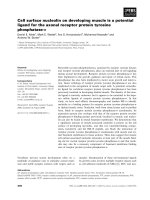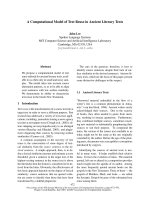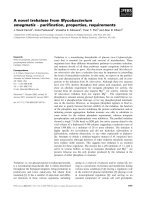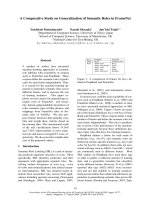báo cáo khoa học: " A renewed focus on primary health care: revitalize or reframe?" potx
Bạn đang xem bản rút gọn của tài liệu. Xem và tải ngay bản đầy đủ của tài liệu tại đây (218.26 KB, 5 trang )
DEBATE Open Access
A renewed focus on primary health care:
revitalize or reframe?
Mrigesh Bhatia
1*
, Susan Rifkin
2
Abstract
The year 2008 celebrated 30 years of Primary Health Care (PHC) policy emerging from the Alma Ata Declaration
with publication of two key reports, the World Health Report 2008 and the Report of the Commission on the
Social Determinants of Health. Both reports reaffirmed the relevance of PHC in terms of its vision and values in
today’s world. However, important challenges in terms of defining PHC, equity and empowerment need to be
addressed.
This article takes the form of a commentary reviewing developments in the last 30 years and discusses the future
of this policy. Three challenges are put forward for discussion (i) the challenge of moving away from a narrow
technical bio-medical paradigm of health to a broader social determinants approach and the need to differentiate
primary care from primary health care; (ii) The challenge of tackling the equity implications of the market oriented
reforms and ensuring that the role of the State in the provision of welfare services is not further weakened; and (iii)
the challenge of finding ways to devel op local community commitments especially in terms of empowerment.
These challenges need to be addressed if PHC is to remain relevant in today’s context. The paper concludes that it
is not sufficient to revitalize PHC of the Alma Ata Declaration but it must be reframed in light of the above
discussion.
Introduction
In 1978, member States of the World Health Organiza-
tion (WHO) attending the meeting in Alma Ata sup-
ported the policy of Primary Health Care (PHC) [1].
This policy shifted the focus of health improvements
from mere provision of health services to the larger con-
text of the relationship between health and social and
economic development. Thirty years later, WHO and its
regional affiliates called for PHC to be revitalised [2].
The purpose of this paper is to identify the major chal-
lenges to this call and investigate the commitments
necessary to achieve this objective. It argues that today
it is not sufficient to seek ways of revitalizing PHC.
Rather it is necessar y to reframe this policy to incorpo-
rate present issues arising from the national and global
context.
Background
PHC analyzed the reasons for health improveme nts
beyond the technical biomedical intervention paradigm.
It argued that other factors were equally important
determinants. PHC in 1978 was underpinned by the
concept of social justice and identified the main princi-
ples of equity and social justice as key to health
improvements. It also highlighted the role of prevention,
multisectoral collaboration, appropriate technology and
sustainability. The need to improve the lot of those liv-
ing in abject poverty was a major emphasis. PHC was a
statement of values as much as a strategy for health
care. The present call to “revitalize” PHC is to once
again bring these values “to life; to animate” them [3].
It can be argued, however, that PHC in the global
context of health care and health needs more than revi-
talization. It is necessary to re-"frame or shape” [3] PHC
so that these principles can be translated from rhetoric
into reality. The struggle to put policy to practice in
PHC can be seen in the debate between Compre hensive
and Selective PHC. The former argued that health
improvements including those related to major diseases
needed to be addressed in a context where health care
delivery takes account of the principles and approaches
described above. The latter argued to achieve PHC, it
was necessary to focus on disease control targeting on
* Correspondence:
1
Department of Social Policy, London School of Economics, Houghton
Street,London, WC2A 2AE, UK
Bhatia and Rifkin Globalization and Health 2010, 6:13
/>© 2010 Bhatia and Rifkin; licensee BioMed Central Ltd. This is an Open Access article di stributed under the terms of the Creative
Commons Attribution License ( nses/by/2.0), which permits unrestricted use, distribut ion, and
reprodu ction in any medium , provided the original work is properly cited.
diseases, which were more prevalent in terms of mor-
bidity and mortality, and were cost effective [4].
The debate continues today. Comprehensive PHC has
shown some remarkable successes, although it has not
been a history of smooth progression. Notable examples
of good programs have been seen in the NGO (non-
government organizations) sector. These programs are
often small scale projects run by charismatic leaders.
Illustrations include Jamkhed in India which became a
model for comprehensive PHC. It provided evidence of
the value of Community Health Workers (CHWs) and a
community development approach to health. Other
examples can be found in the book by Taylor-Ide and
Taylor [5].
On a national scale evidence is more restricted. The
world’s two most populated countries returned to PHC
principles to address the health needs o f the poor.
ChinawasthecountrythatinspiredPHCthinking
through its attention to rural health care and the use of
local people called “barefoot doctors” (CHWs) to give
first line health care. After a period of mark et oriented
reforms in health care and the resulti ng deterioration of
the health of rural people who are the nation’spopula-
tion, China is now committing huge additional resources
to revitalising rural networks based on PHC [6]. India,
which was one of the first countries to create a national
community health worker scheme after the Alma Ata
conference and subsequently saw the scheme disappear
within 10 years, has now begun to revive the program
in the context of the National Rural Health Mission [7].
Thailand having adopted a “Basic Needs” approach in
the 1970s established a health system based on an alli-
ance between, government and NGOs that integrated
PHC programs into other development programs. This
alliance has produced both better health and economic
improvements [8].
The year 2008 celebrated 30 years of PHC policy. Two
major reports, the World Health Report 2008 [9] and
the Report of the Commission on the Social Determi-
nants of Health from WHO [10] provided key contribu-
tions to this celebration. Both reaffirmed the relevance
of PH C in terms of its vision and values in today’s
world. In addition, a number of articles in the special
issue of The Lancet [11] and in the Global Social Health
Policy Forum written by public health researchers and
activists summarise the influence of PHC on health pol-
icy [12]. However, at the risk of an understatement, the
world has changed radically since 1978. The world in
2008, can be broadly described as one characterised by
globalisation, rapid communication and an increasing
gap between rich and poor. In the context of health and
health care it can be described as one which has seen a
shift from major concerns about communicable diseases
to chronic diseases (from targeted single interventions
to concerns about environment, life style and beha-
viour); ideological changes (as dictated by neoliberal
economics and new public management) along with
dominance of Br etton Woods institutions over the UN
organisations resulted in developing countries embra-
cing market oriented health sector reforms [13]; and a
shift from medical professional monopoly on decisions
and resource allocation to a much wider role for lay
people [14]. This situation presents large challenges and
demands serious rethinking about the PHC vision.
Challenge One: Agreeing upon definitions
There is a challenge of getting a consensus among those
involved in health care delivery and policy that health
improvements must be seen in the context of linking
health care and human development. In 1978, the idea
of seeing health as a reflection of the wider socio-
economic determinants was questioned by many of
those working in the field of health. In putting forward
the PHC policy, WHO used the personal experiences of
people to give evidence of the link between health and
development. Drawn m ainly from less developed coun-
try experiences, those who contributed to this analysis
were often charismatic doctors whose leadership and life
improved the health of the poor with whom they
worked. Coinciding with the widely reported achieve-
ments in health improvements in the newly created Peo-
ples ’ Republic of China that viewed health as integral to
development, the argu ments that health was more than
medicine and services gained credence among providers
and policy makers. A book entitled “Health by the Peo-
ple” edited by Dr. Ken Newell, head of the division that
crafted the PHC policy published proof of these accom-
plishments [15].
However, these views and arguments were not shared
by the majority of those involved in health care. Many
believed that there was little hard evidence to support
the view that the socio-economic environment was as
critical to health improvements as medicine and service
delivery. As a result, although the arguments of social
justice and equity were received with sympathy, imple-
mentation of policy mostly focused on service provision.
One example is selective vs. comprehensive debate dis-
cussed above.
Another was the confusion of the concepts “Primary
Health Care” and “primary care”. Those concerned with
health care delivery could embrace the PHC vision in
thecontextofservicedeliveryforwhichtheywere
responsible. As a result their focus became providing
first line health services, “primary care”, for communities
but not engaging in the wider analysis of conditions in
which the poor health problems were created nor ser-
iously engaging in activities to promote equity and com-
munity participation. The concept of primary care for
Bhatia and Rifkin Globalization and Health 2010, 6:13
/>Page 2 of 5
many of these people was interchangeable w ith Primary
Health Care and has continued to be so. A recent spe-
cial issue of Lancet on 30 years of celebration of Alma
Ata is a good example of the confusion in the under-
standing of differences between these two concepts [11].
A lack of a wider context for dialogue of the causes of
and solutions to poor health creates considerable confu-
sion for both policy planners and program implemen-
ters. In an attempt to clarify the relationship between
Primary Health Care and primary care the Report of the
Commission on the Social Determinants of Health
states:
“The Alma Ata Declaration promoted Primary
Health Care (PHC) as its central means toward good
and fair global health–not simply health services at
the primary care level (though that was important)
but rather a health system model that acted also on
the underlying social, economic and political causes
of poor health”. [[10]: pg.33].
A commitment to reject the duality between Compre-
hensive PHC and Selective PHC and an agreement for a
standard definition of PHC and the attributes it encom-
passes is necessary to create solid frameworks for policy
analysis and health promotion.
Challenge Two: Ensuring equity
A second challenge is addressing the equity implications of
the market oriented reforms introduced in number of
developing countries. The Report of the Commission on
the Social Determinants of Health highlighted equity, both
in terms of distribution but also in terms of power and
politics. Both PHC and the Report of the Commission call
for universal coverage. They highlight problem of market
oriented approaches and give evidence o f its failure to
meet objectives for improving health for the poor.
The reduced access to health care as a result of the
Structural Adjustment Programs (SAP) of the 1980s
provides the most graphic example illustrated by the
reduction of l ife expectancy in Africa [16]. In the field
of health, these programs combined with neo-liberal
emphasis on the role of the market economy to improve
efficiency and effectiveness has resulted in the promo-
tion of a health system reforms (HSR). These market
oriented reforms include decentralization, public private
partnerships, promotion of the private sector, and intro-
duction of user charges [17,18]. Although often couched
in the PHC principles of equity and participation, t hey
respondtothedemandsofefficiencyatthecostof
equity considerations [13]. As a result, short-term gains,
in many cases, have overridden longer-term concerns
that address the root cause of poverty and poor health
[19].
Equity implications of the market oriented reforms are
well documented. A classic example is the introduction
of user charges. User charges for health care were intro-
duced as a part of the structural adjustment programs
in number of countries. However, the expected benefits
in terms of efficiency and equity were not forthcoming.
The negative consequences in terms of access and utili-
sation of health services were observed especially among
the lower socio-economic groups across countries.
Given the highly regressive nature of user charges and
the lack of effective exemption mechanisms, it is there-
fore not surprising to observe number of countries in
Sub-Sahara Africa have abolished user fees or are in the
process of doing so [20].
At the global level, the global public private partner-
ships (i.e. Global alliance on vaccine initiative (GAVI),
Global funds for Aids, TB and Malaria (GFATM) have
funded technology for health focusing on prof it rather
than people and have re-enforced vertical disease pro-
gram approach. This approach has been criticised for
distort ing national priorities, weakening the comprehen-
sive integrated health systems approach and supporting
re-verticalization of planning [21] as energies are direc-
ted t owards implementing specific vertical disease
programs.
Challenge Three: Supporting community
participation and empowerment
A final major challenge is to examine and seek ways for-
ward to develop local community commitments. Com-
munity parti cipation was identifi ed as a key principle of
PHC. There was little d istinction between participation
as community mobilisation (having community peo ple
accept professionals’ assessment and activities for health
improvements) and community empowerment (trans-
forming attitudes and behaviours that enable commu-
nity/individuals take decisions about their own lives). In
recent years, recognit ion of th e differences has increased
and the term participation has increasingly been
replaced by empowerment, calling attention to the
importance of power and control over decisions, espe-
cially resource allocation.
The direct link between community participation and
empowerment has not been easy to establish [22]. How-
ever the link has been strengthened by a recent systema-
tic review un dertaken b y the Working G roup on
Community Based Primary Health of the American Pub-
lic Health Association [23]. In a paper published in Glo-
bal Public Health their findings show that community
involvement including house to house visits by health
staff, group meetings for education and support on
health issues, outreach workers providing health services
in the community and a community level (CHW) health
worker to support community based health management
Bhatia and Rifkin Globalization and Health 2010, 6:13
/>Page 3 of 5
has measurable effects on improvement of child survival.
They also highlight empowering communities (meaning
community people gain skills, information and confi-
dence to make decisions about their choices affecting
their own lives) as an overarching strategy that under-
pins these gains.
Issues around participation and empowerment also
have been promoted in the context of governance of
health service provision. A growing literature argues
that concerns about accountability of public expendi-
tures should be placed in the hands of those intended
beneficiaries of those services. These issues centre on
both the accountability of services to perform to the
satisfaction of the users and the accountability of
finances to be used in the way in which they have been
allocated. Concerns are developed in discussion about
“voice” whereby service users have the ability and capa-
city to demand the providers perform to user satisfac-
tion. Evidence from the implementation of t he Bamako
Initiative shows how accountability can catalyze
improvement in efficiency and effectiveness of local ser-
vice delivery [24].
Commitments to meet this challenge continually
demand professionals to hold serious dialogues with
those for whom they provide service and care. To date
this dialogue has often been delayed by several factors.
Firstly, there is the existence of attitudes of professionals
who tend to disregard opinions and views of those out-
side the profession. Secondly, there is the historic view
that health interventions can only be verified by out-
come measures. This view ignores the vital role of pro-
cess in sustaining the improvements that bio-medicine
and technology contribute. The World Health Report
2008 discusses in detail the role of service providers yet
does not address the second issue of process. Commit-
ment to addressing both issues is critical to PHC in the
present context.
Conclusion
Above we have identified the challenges and necessary
commitments that need to be addressed if PHC is to
remain relevant. Revitalizing PHC principles without
developing a framework to address concrete measures
for health improvements is not sufficient. The chal-
lenges discussed above need to be examined in a sys-
tematic and integrated way to produce flexible policy
options and solutions t hat can be implemented. To do
this, particularly in a time of financial crisis, requires a
willingness to dialogue and appreciate a range of differ-
ent and often contradictory views working toward con-
sensus. It is clear that more of the same will no t answer
increasingly risky situations emerging from not only lack
of money but also climate change, international political
tensions and growing anxiety about resource availability
due to rapidly expanding global populations. This does
suggest that perhaps revitalizing PHC is not sufficient.
What is needed is a reframing of the concept in light of
the above discussions around the issues identified.
Acknowledgements
Dr Bhatia spent some of his buy-out time working on this paper and so
would like to acknowledge the TISS-LSE Tata project funded by Tata Trust
for supporting his buy-out.
Author details
1
Department of Social Policy, London School of Economics, Houghton
Street,London, WC2A 2AE, UK.
2
Institute of Social Psychology, London School
of Economics, Houghton Street, London, WC2A 2AE, UK.
Authors’ contributions
Both authors have contributed to the planning, writing and editing of this
paper. Both authors have read and approved the final version of this
manuscript.
Competing interests
The authors declare that they have no competing interests.
Received: 15 January 2010 Accepted: 30 July 2010
Published: 30 July 2010
References
1. Declaration of Alma-Ata: International conference on primary health care.
Alma-Ata, USSR Sept 1978, 6-12[./hpr/NPH/doc/
declaration_almaata.pdf], (accessed 15 November 2009).
2. Pan American Health Organization: Renewing Primary Health Care in the
Americas. Washington DC: PAHO 2007.
3. Oxford Shorter Dictionary. Oxford: Oxford University Press, 3 1973.
4. Rifkin S, Walt G: Why health improves: defining the issues concerning
‘comprehensive primary health care’ and ‘selective primary health care’.
Soc Sci Med 1986, 23:559-566.
5. Taylor-Ide D, Taylor C: When communities own their future. Baltimore:
John Hopkins Univ Press 2002.
6. Yip W, Hsiao W: The Chinese Health System At A Crossroads. Health
Affairs 2008, 27(2):460-468.
7. Government of India: National Rural Health Mission document; Ministry
of Health and Family Welfare New Delhi. 2005.
8. Chuengsatiansup K, Srivanichakorn S: Localizing global policy: the
experience of Primary Health Care in Thailand. Three decades of Primary
Health Care: Reviewing the past and defining the future 2008 Bangkok:
Prince Maidhol Award Conference[],
accessed August 9,2008.
9. World Health Report: Primary Health Care: now more than ever. World
Health Organization Geneva 2008.
10. Commission on the Social Determinants of Health: Closing the gap in a
generation. World Health Organization Geneva 2008.
11. The Lancet: Alma-Ata 30 years on: “Health for all need not be a dream
buried in the past”. The Lancet 2008, 372:917-1007.
12. Koivusalo M, Baru R: Reclaiming Primary Health Care-Why does Alma Ata
still matter? Or can we still speak of the relevance of Alma Ata? Global
Social Policy Forum. Global Social Policy 2008, 8(2):147-166.
13. Sen K, Koivusalo M: ’Health care reforms and developing countries - a
critical overview’. International Journal of Health Planning and Management
1998, 13:199-215.
14. Florin D, Dixon J: “Public Involvement in Health Care”. BMJ 2004,
328(7432):159-161.
15. Newell K: Health by the people. World Health Organization Geneva 1975.
16. Jolly R: Adjustment with a human face: A UNICEF record and perspective
on the 1980s. World Development 1991, 19(12)
:1807-1821.
17. World Bank: World Development Report: Investing in health. Washington
DC 1993.
18. Bhatia M, Mossialos E: ’Health Systems in developing countries’. In Social
Policy for Development. London: SageHall A, Midgley J 2004,
168-204.
Bhatia and Rifkin Globalization and Health 2010, 6:13
/>Page 4 of 5
19. Green A: Have health sector reforms strengthened PHC in developing
countries? Primary Health Care Research and Development 2004, 4:289-295.
20. Gilson L, McIntyre D: Removing user fees for primary care in Africa: the
need for careful action. British Medical Journal 2005, 331:762-765.
21. Biesma R, Brugha R, Harmer A, Walsh A, Spicer N, Walt G: The effects of
global health initiatives on country health systems: a review of the
evidence from HIV/AIDS control. Health Policy and Planning 2009,
24:239-252.
22. Hossain SM, Bhuiya A, Khan R, Uhaa I: Community development and its
impact on health: South Asian experience. BMJ 2004, 328:830-833.
23. Freeman P, Perry HB, Gupta SK, Rassekh B: Accelerating progress in
achieving the millennium development goal for children through
community-based approaches. Global Public Health 2009, 3:1-20.
24. Mehrota S, Jarrett S: Improving basic health service delivery in low-
income countries: ‘voice’ to the poor’. Social Science and Medicine 2002,
54:1685-1690.
doi:10.1186/1744-8603-6-13
Cite this article as: Bhatia and Rifkin: A renewed focus on primary
health care: revitalize or reframe?. Globalization and Health 2010 6:13.
Submit your next manuscript to BioMed Central
and take full advantage of:
• Convenient online submission
• Thorough peer review
• No space constraints or color figure charges
• Immediate publication on acceptance
• Inclusion in PubMed, CAS, Scopus and Google Scholar
• Research which is freely available for redistribution
Submit your manuscript at
www.biomedcentral.com/submit
Bhatia and Rifkin Globalization and Health 2010, 6:13
/>Page 5 of 5









